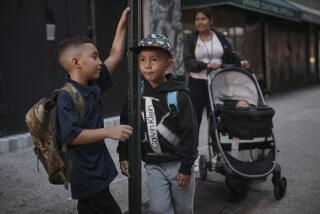Same Tall Ships, a ‘New’ New York : City Has Made Big Strides in 10 Years Since Bicentennial
- Share via
NEW YORK — It was a memorable moment of another era:
Precisely at 11 a.m., while millions of spectators on both banks of the Hudson River cheered, the Coast Guard’s three-masted bark Eagle--jib sails, stay sails and spanker rising high above her proud white hull--entered New York Harbor at the head of a majestic flotilla of tall ships. The occasion was a celebration of the nation’s Bicentennial.
This week--one decade later to the day--the tall ships once again will sail into New York’s harbor for an Independence Day parade, this time to salute the Statue of Liberty.
Many of the sailing vessels will be the same ones seen in 1976. What will be different is the city they are visiting.
New York--always evolving, as all cities do--has undergone some remarkable changes in the 10 years between the two harbor parades. The city was on the brink of bankruptcy in l976; today its financial condition is dramatically improved. Its job market has recovered. New skyscrapers grace its skyline, and cast more shadows into its streets.
Sharply Divided Economy
The city is more international, yet some neighborhoods have lost character. And no continuing problem is more serious than the growing concentrations of rich and poor as the city’s middle class continues to diminish in numbers.
On the eve of Operation Sail in l976, Mayor Abraham D. Beame visited the aircraft carrier Forrestal, which was to serve the next day as a reviewing stand for 3,000 guests. Crewmen presented him with a cake decorated with a big red apple. “I’ve had a lot of experience cutting,” the mayor, a central figure in the fiscal crisis, joked ruefully.
The financial troubles that shook New York City to its economic and social foundations have ended, but not without leaving some worrisome scars. A succession of balanced budgets and prudent financial practices have allowed the city to recover, and to re-enter the monetary marketplace with favorable ratings.
The Emergency Financial Control Board, which acted as a watchdog over municipal spending, was to have its final meeting today, its mission completed.
“Financially, the city’s fiscal position is night and day,” said Felix Rohatyn, the investment banker who chairs the state-sponsored Municipal Assistance Corp., the agency that stretched out the city’s debt and helped to improve management and budget practices.
Contrasts Over Decade
“Ten years ago, we had a runaway deficit: $6 billion in short-term debt, no market, deep misgivings about the city’s future and a loss of businesses. Now, we are in the fourth year of a budgetary surplus, with the most rigorous accounting system in the country,” Rohatyn said.
New York’s economy also has improved dramatically since 1976. Between 1969 and 1977, the city lost more than 600,000 jobs--almost a sixth of its employment base. During the 1970s, New York’s population fell by almost 1 million as flight to the suburbs and other regions of the country accelerated.
In their series of books, “Setting Municipal Priorities,” Raymond D. Horton and Charles Brecher sketched the dimensions of the city’s decline. The number of jobs New York lost, they observed, was equivalent to the total employment of San Diego. The population loss was like one of the nation’s 10 largest cities disappearing.
A decade later, the job situation has been reversed. Starting in 1977, the New York economy began to recover. Employment increased strongly in the service sector, insurance, construction, finance and real estate. The city has begun a massive program to rebuild deteriorating bridges, parks, sewers and highways, to resume maintenance deferred during the fiscal crisis.
‘A Stunning Recovery’
Samuel M. Ehrenhalt, the U.S. Department of Labor’s regional commissioner of labor statistics, said: “When you look at the record over the last eight years, you have a stunning record of recovery, with over a quarter of a million jobs added in the private sector. We have now had a period of growth as long as the decline that preceded it.”
But for all this progress, New York in many ways remains a city deeply divided between wealth and poverty, with a middle class besieged by both extremes.
“There is this tale of two cities,” said Rohatyn. “You have this dazzling wealth in Manhattan and this great misery in parts of Brooklyn, Queens and the Bronx. How to reduce this gap is an enormous challenge.”
The visitors crowding into Manhattan this week can find a cornucopia of delights, among them the Metropolitan Museum of Art, Lincoln Center for the Performing Arts, the revitalized South Street Seaport emporium, Madison Avenue and its numerous international shops and art galleries, luxury department stores and expensive restaurants galore.
New Buildings Abound
In some Manhattan neighborhoods, new apartment houses seem to sprout monthly. Rents are now so high in some parts of Manhattan that young, working college graduates are living two and three to a room. Because of the cost of living here, the starting salary for law school graduates on at least one law firm is $70,000 a year.
Store rentals in Manhattan can be even higher than housing costs. The result of this has been the closing of many of the small, family-owned shops that have given character and diversity to New York’s neighborhoods.
Over these 10 years, New York has become more cosmopolitan as wealthy foreign families fleeing political and economic instability have arrived, along with waves of other immigrants in pursuit of the American dream. In portions of Queens, across the East River from Manhattan, the latest influx of immigrants is most apparent. The faces of Latins, Asians, Indians and other newcomers are familiar sights on the streets.
New York’s skyline also has changed dramatically in 10 years. When the tall ships sail up the Hudson, they will pass near Battery Park City, a $4-billion, 92-acre development that will eventually accommodate 31,000 workers in 6 million square feet of office space. About 30,000 people will live in Battery Park City’s 14,000 apartments. In essence, a neighborhood has been created in the shadows of the World Trade Center’s twin towers.
New Skyscraper Profile
The ships will also pass the recently opened Jacob K. Javits Convention Center, with its massive facade of glass. In Midtown, the many new skyscrapers include the American Telephone & Telegraph corporate headquarters, with its Chippendale-style pediment.
Because the news media concentrate on Manhattan, positive changes in the other boroughs tend to be ignored. In Brooklyn, plans are under way for the first new hotel in years. Ground was broken last month for a large office building to house some operations of Wall Street firms, and a $300-million complex of 2,200 apartments is planned for the Brighton Beach neighborhood. Parts of the South Bronx, once the leading symbol of urban blight, are wasteland no longer. New housing and businesses have brought hope and a measure of economic revival to South Bronx neighborhoods.
Still, there is the other New York. The number of homeless people continues to grow, at a rate some estimate at 10% a year. Day and night, men and women with their belongings in battered suitcases or trash bags can be seen huddled in doorways. There are ambitious plans, but a desperate shortage of housing for the poor and the homeless.
New York’s public school system remains deeply troubled. At least 40% of the students who start high school never finish. On a typical day, 15% or more of all pupils skip school. City and school officials fear that thousands upon thousands of youngsters will grow up unprepared to compete in an increasingly technology-oriented job market--that, to a large degree, they will be a lost generation.
Decline of Wealth
The flight from the city has left New York with a population that is poorer. Between 1970 and 1980, Horton and Brecher noted, the number of New Yorkers living in poverty increased by 25% as the city’s population was dwindling by 11%. At least a third of New York City’s children--about 550,000--are being raised on family incomes below the poverty level, and two-thirds of these youngsters live with one parent. The task of educating them is immense.
The city has started an ambitious program to modernize its subway system, but large infusions money will be needed in the years ahead. The subways remain overcrowded, unpleasant, unreliable and, at times, dangerous. The municipal hospital system has improved, but it is increasingly strained by the cost of caring for the large and growing numbers of people suffering from acquired immune deficiency syndrome.
More to Read
Sign up for Essential California
The most important California stories and recommendations in your inbox every morning.
You may occasionally receive promotional content from the Los Angeles Times.










